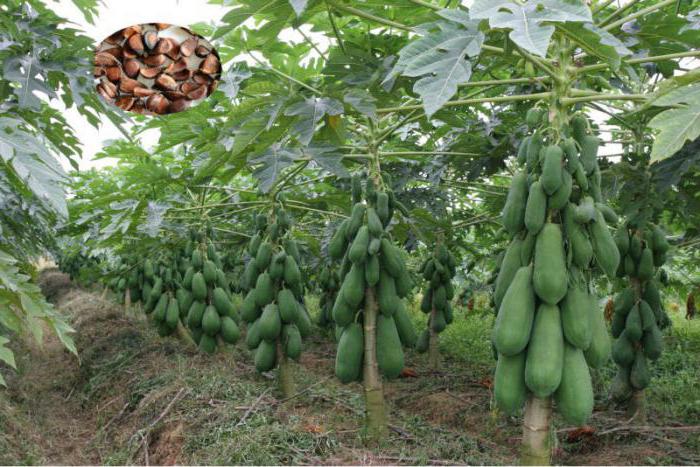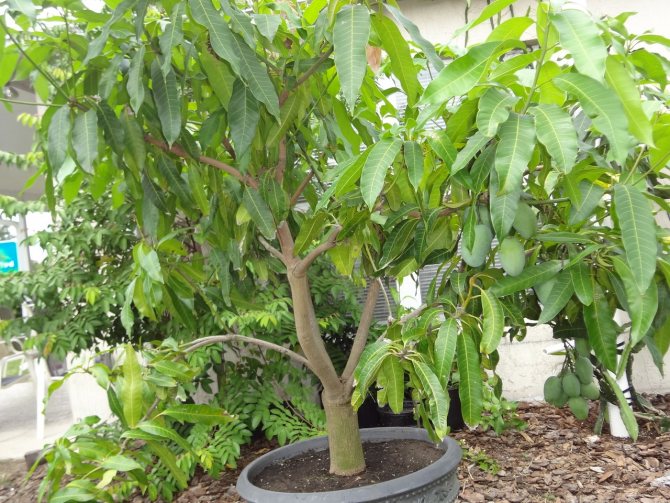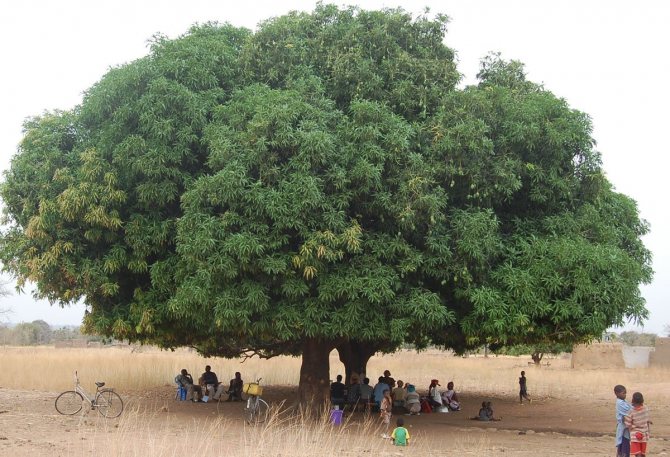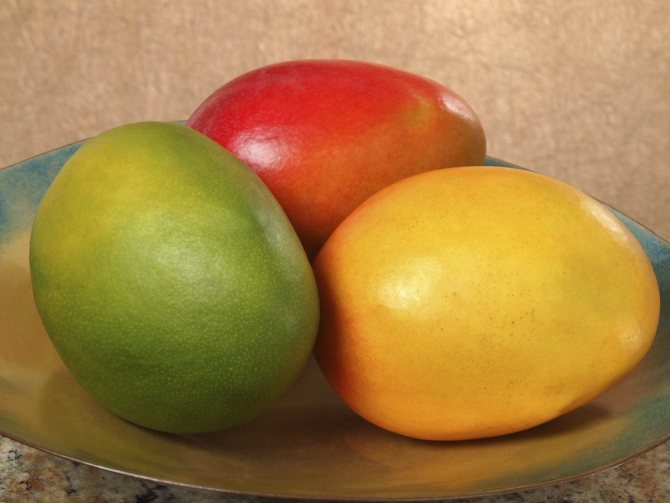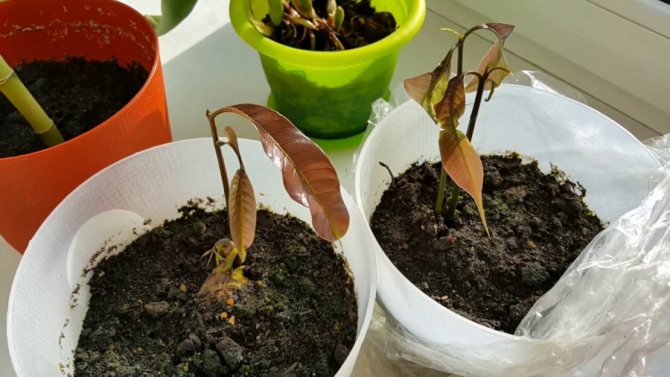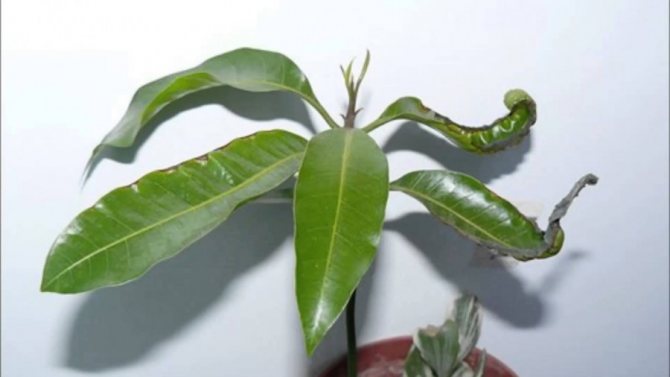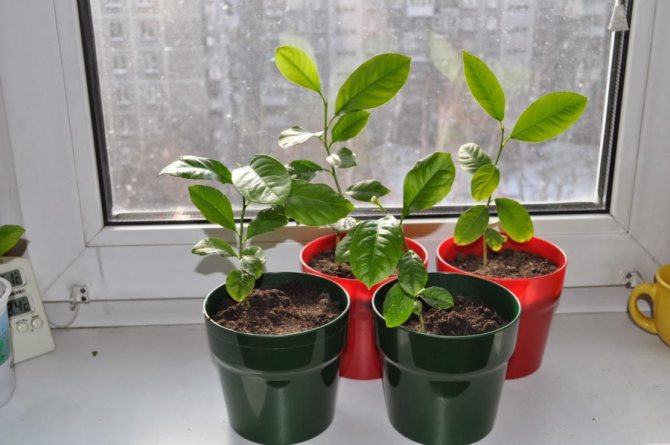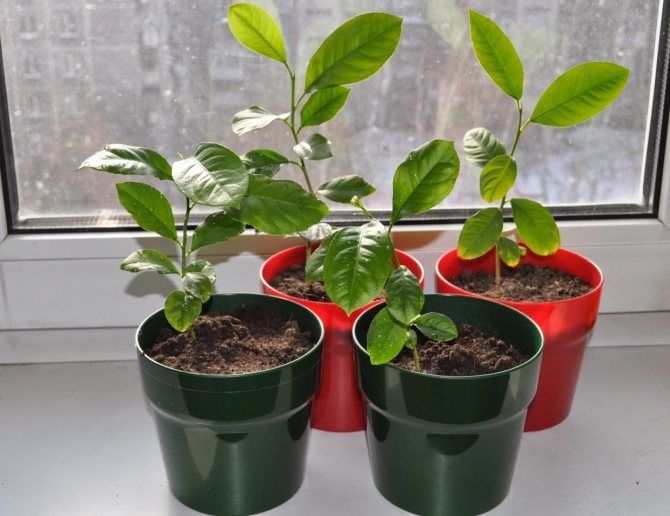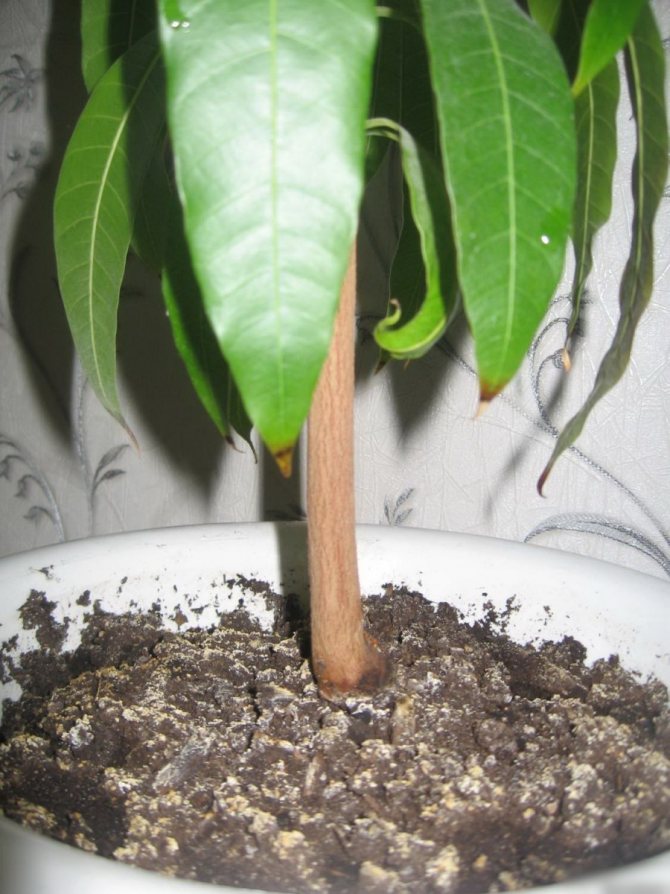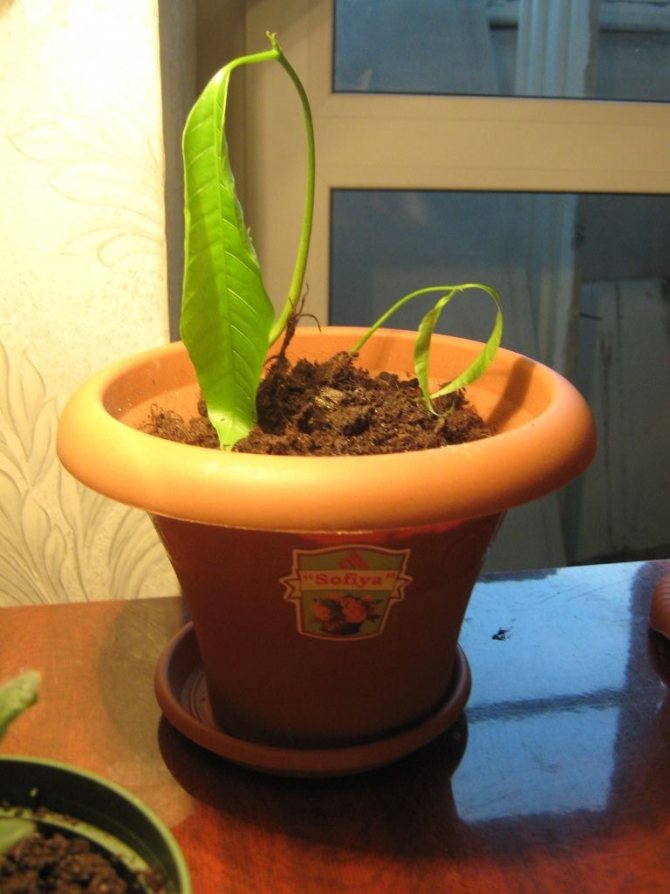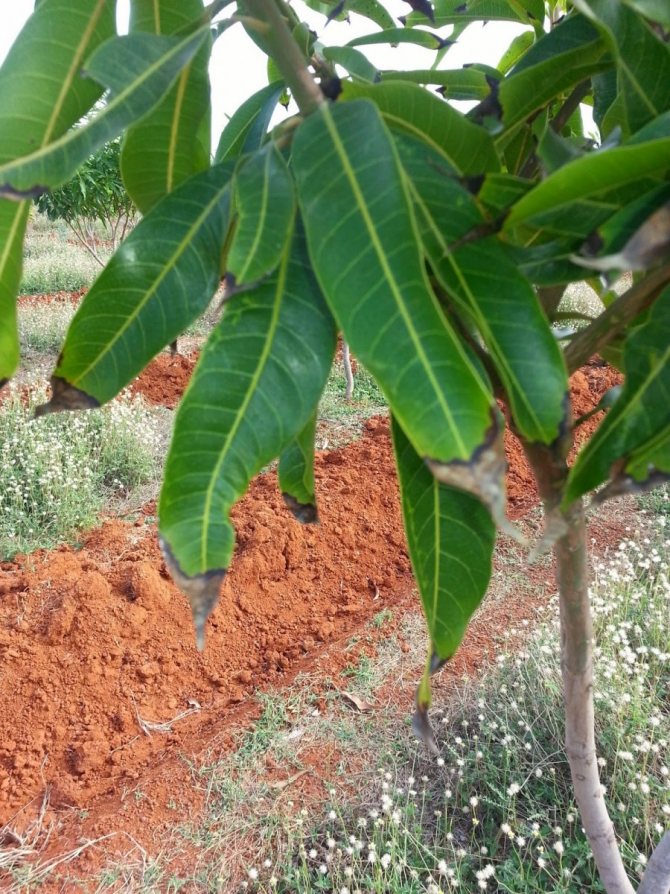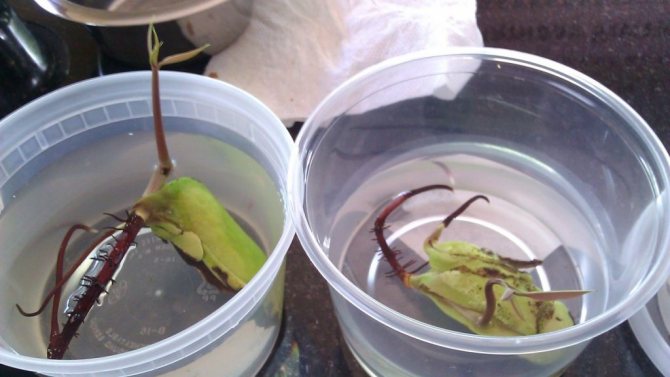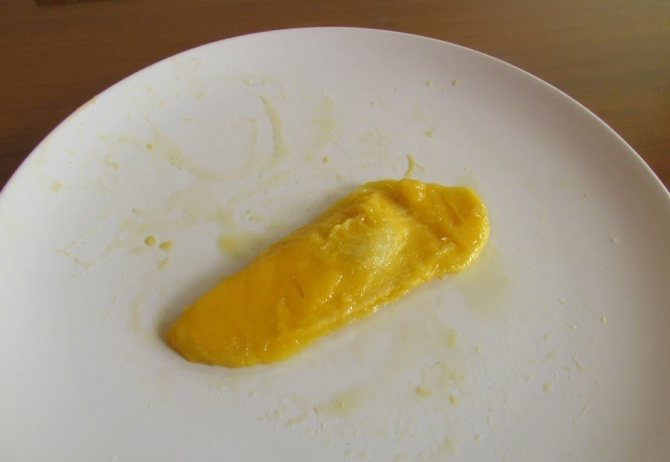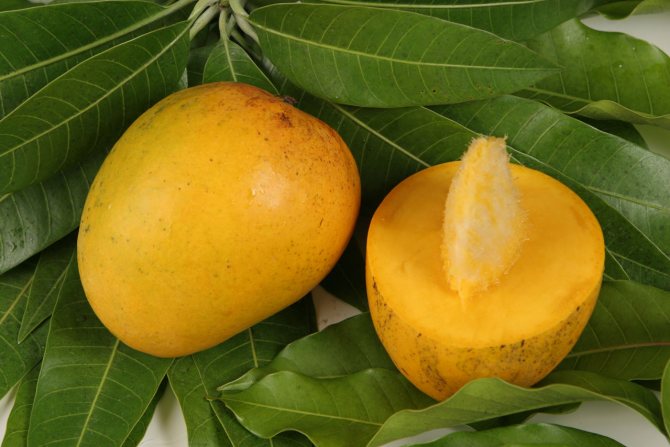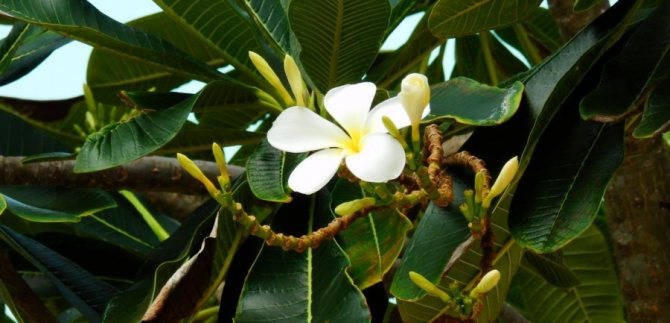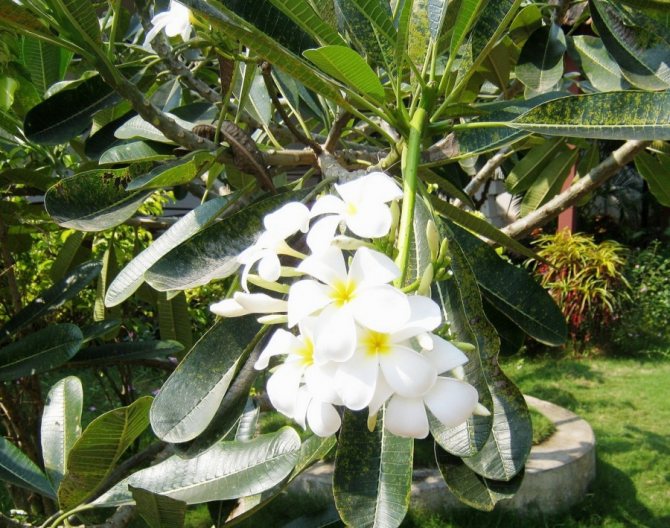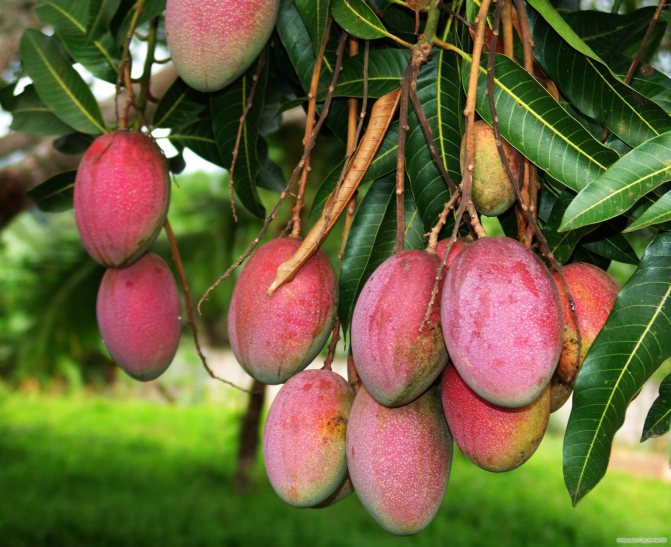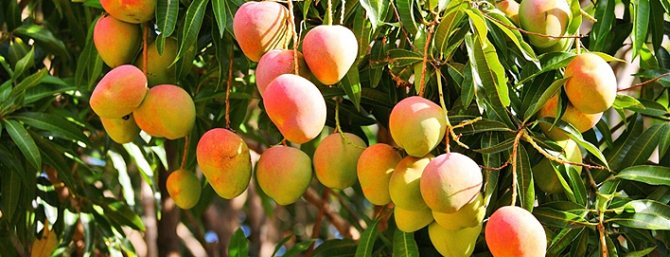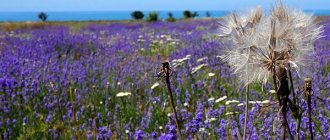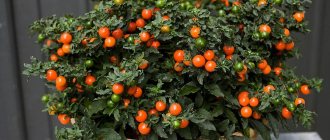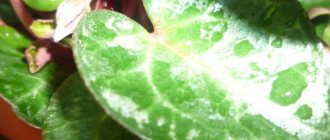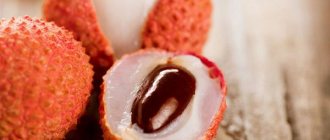Until relatively recently, mango was a real wonder for Russians; it was seen only in Brazilian TV shows, and not on domestic shelves. Today, this great fruit (and this is how it literally translates from Sanskrit) can be freely bought and enjoyed its tender, aromatic pulp with a lot of minerals and vitamins. Such properties increase the popularity of the fruit and more and more questions arise: "Where does the mango fruit grow and can it be grown with your own hands?" Let's try to figure it out.
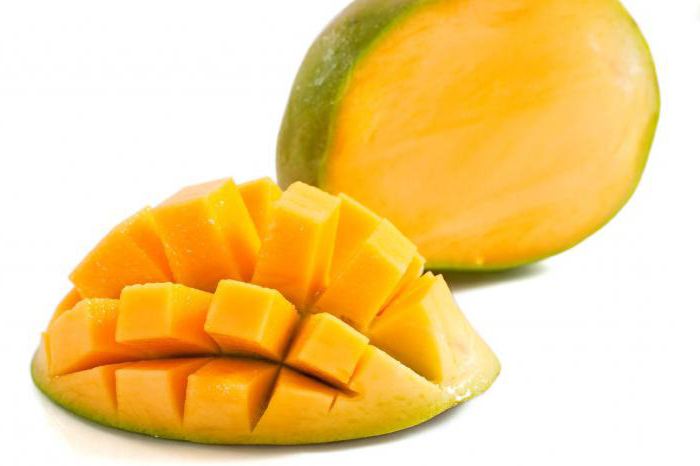
Is it possible to grow mango
The mango tree is quite unpretentious, it can well grow both in an apartment and in a country house. Its fruits are tender and have an unsurpassed taste. Cuttings can be purchased from nurseries. It is in this way that it is best to plant and plant mango trees, they take root better, care is much easier. Purchased cuttings bloom and bear fruit over time. They do not need to be vaccinated subsequently.
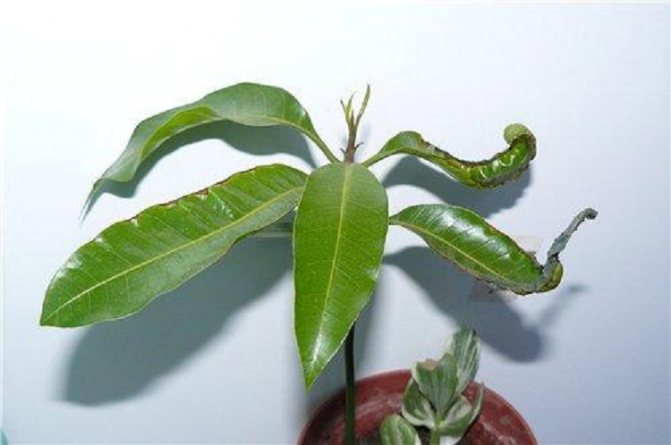

If you originally planted the purchased plant in a pot that does not match the roots, you should not transplant it. It must get stronger, take root. A subsequent transplant can be carried out after a year. During this period, nothing terrible will happen, the root system will develop. Due to the fact that there is not enough space for her in such a pot, the tree will stretch in growth, branch out. After the next transplant, its growth will dull, the roots will develop vigorously.
It's worth knowing. If the pot is small, the roots are cramped, the trunk, twigs grow vigorously, the leaf crown develops. If the pot is too free, the roots grow vigorously, the development of the trunk and crown becomes dull.
Frequent transplanting injures the root system, the tree will ache, in a state of stress it can throw off the entire leaf crown, dry out.
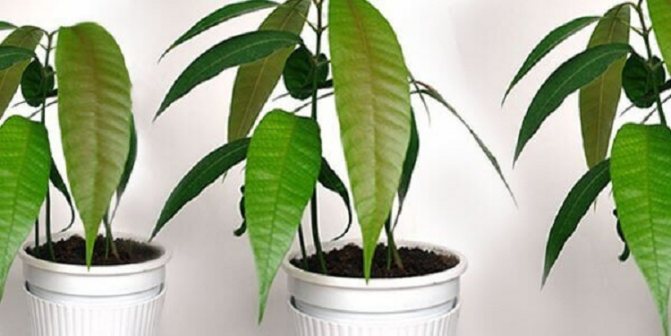

Climatic conditions must be recreated according to the habitat, with a high level of humidity, the norm is not less than 80%. Dryness of the soil and air will lead to shedding of leaves and drying of the roots, subsequently the tree will die. Too frequent irrigation of the crown can lead to the formation of fungi and the appearance of mold. Diseases spread quite quickly, it will be difficult to save the plant.
Healing properties
In places where mango has been growing for many centuries, it is used not only for food, but also for medicinal purposes. There, it is believed that the use of this fruit helps to prevent cancer of the organs of the genitourinary system.
It is also used as a natural immunomodulator, thanks to the combination of vitamins B, C and carotene. Mango is also credited with the ability to relieve nervous tension, improve mood, overcome stress and significantly increase a person's sexual abilities.
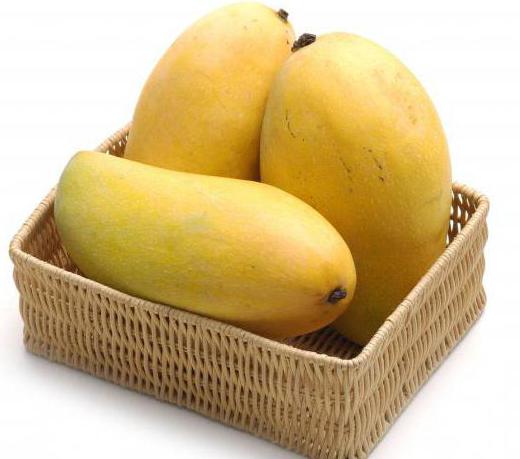

The content of certain enzymes and a large amount of fiber in the "great fruit" gave rise to the idea of using it to calm the stomach, and regular consumption guarantees the prevention of constipation and colon diseases.
Is it possible to grow a mango from a seed
At home, you can grow a beautiful, healthy tree using the bone of a ripe fruit. It must be placed in the ground immediately after being removed. Initially, choose the ripe fruit, green will have a bad effect on germination. From a ripe fruit, the core leaves easily.It is not recommended to plant a closed bone in the soil; it is better to carefully remove the seed by opening it with a sharp knife blade.
After opening, the inside of the bone is treated with special means. They prevent the appearance of pathogenic bacteria. Next, the seed must be placed in the soil and lightly sprinkled.
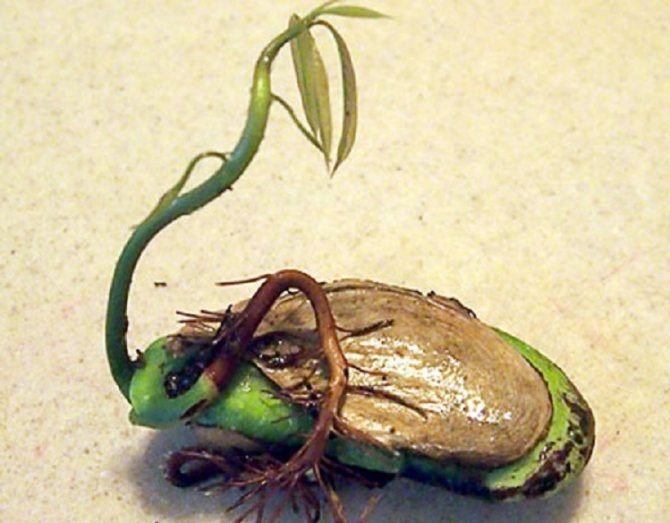

Until the shoots appear, it will take up to 14 days. From time to time you need to look under the film, spray some water. Future seedlings need a lot of sunlight. If you cannot provide additional lighting, place the container with seedlings on a well-lit windowsill. The south side is best suited for this. When the plant's stem gets stronger, starts to grow stiff, it needs to be grafted, otherwise the mango tree will be a simple ornamental plant, without fruits.
Initially, it is recommended to select a voluminous pot, fill it with high-quality soil. After all, the plant should not be moved to new soil more often than once a year. By their nature, mango trees are tall, with a highly developed root system.
The birthplace of the fruit
Useful properties, pleasant taste and an element of exoticism increase the popularity of this fruit more and more every day. Questions arise: “Where does the mango grow? In what countries? What varieties are there? " Today, about 20 states are engaged in the cultivation and supply of this fruit. But the original homeland of the beautiful and prolific mango tree is India. In addition, among the Hindus, it is considered the embodiment of the god Prajayapati ("Creator of All That Is").
It is India that is the "main" country where mango grows: today there are about 100 varieties of it.
The history of the emergence of the mango tree can be considered the period of the IV-V centuries BC. BC when it was introduced to Malaya and East Asia by itinerant Buddhist monks. And in the 10th century A.D. e. mangoes were brought by the Persians to the countries of East Africa. That is, in general, this exotic fruit has existed for about 6 thousand years. Mango was originally a small, dry and wiry fruit. But in the course of natural crossing of its two varieties, the well-known fragrant, soft and juicy fruits turned out.
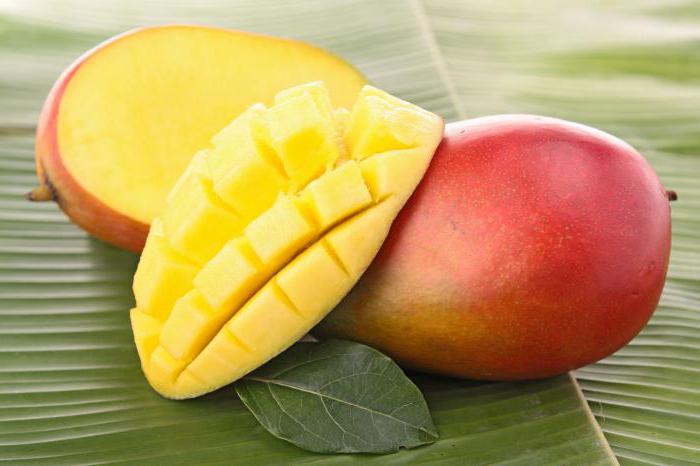

How to grow a mango at home, step-by-step instructions
Mango trees grow well in warm climates, in open courtyards. Grown up and stronger, they bear fruit for many years. You can grow them from the acquired sprouts immediately on the site. The following conditions are considered optimal:
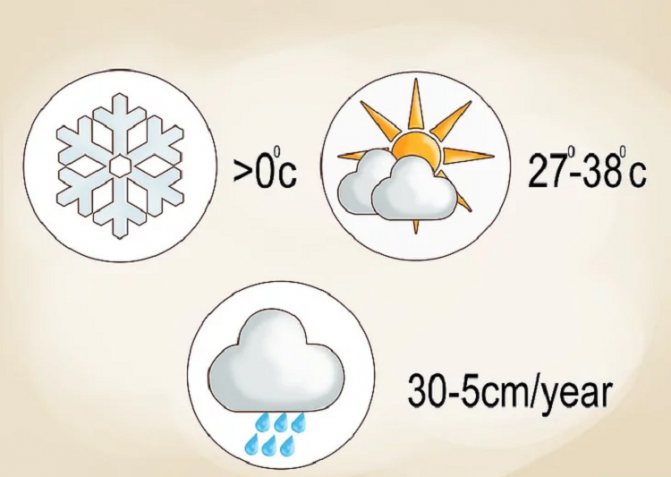

If you grow trees in northern latitudes, you need to protect them from frost. For this, devices are built, covered. You can plant trees in boxes, and clean them in warm rooms for the winter. The landing sites should be well lit, there should be no drafts either. Do not plant them in shady areas next to other trees. The distance to the nearest trees / bushes is at least 3 - 5 meters.
The tree can grow from purchased cuttings or mango seeds.
- You can grow a strong tree from seeds. For this, it is better to choose the "poly-embryo" fruit. Only from its seeds will a tree grow without grafting. At least 8 years will pass before the start of fruiting.
- You can grow a tree from cuttings, they bear fruit after 3 years.


Planting, transplanting is best done from late April to early July. It is during this period that it rains, the sun shines brightly. This option is suitable for transplanting a plant from a stone. If you are planting a cutting, follow the recommendations given in the nursery. There are varieties that are best planted in late summer - early autumn.
The soil must be acidified. The best mixture is sand with peat, it is quickly saturated with water, it keeps it longer. Planting depth is determined by the height of the stem prior to bud formation.A hole is dug no more than 60 cm in diameter, filled with a compost composition in half with a peat-sand mixture. After transshipment of the plant, there is no need to tamp the soil. The mango tree loves loose soils.


A home-grown mango tree should receive the required amount of fertilizer. To do this, add a mixture of organic humus, compositions containing nitrogen and its complexes. After transplanting to a permanent place of growth (open ground), it is necessary to fertilize with organic matter within a radius of a meter from the trunk.
It is not recommended to feed with salt formulations. They slow down the growth and rooting of trees. After germination, fertilizing is applied 1 time / 30 days, if it is organic. The first time it is brought in after the formation of the third pair of leaves. Non-organic is introduced according to the instructions.
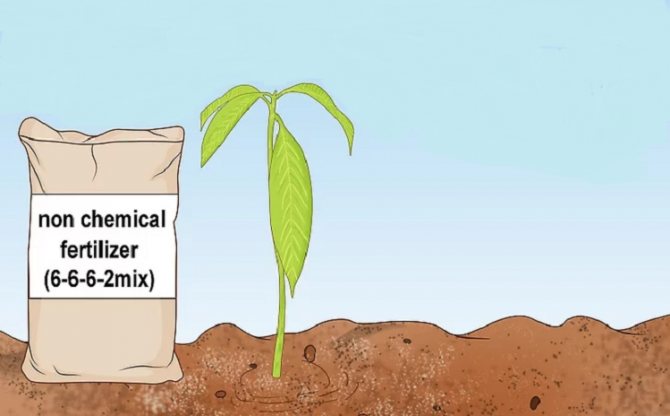

Immediately after transshipment to a permanent place of growth, frequent watering is carried out. From the second week and the entire first year, no more than twice a week. Remove weed, mulch, hold moisture near the roots.
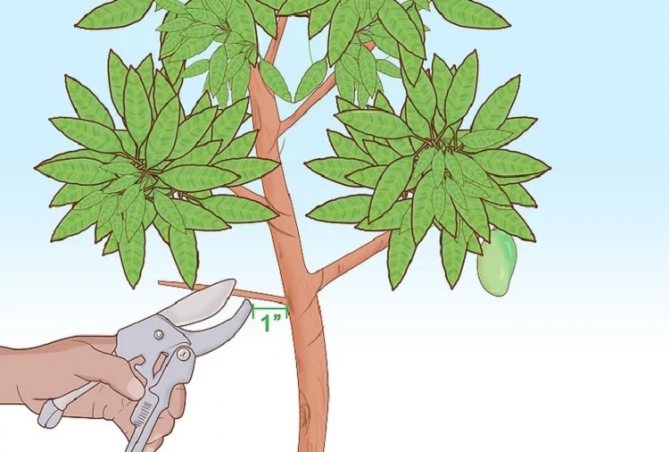

A grown, matured tree can be cut off and a hat can be formed at your discretion. Upon reaching 100 cm, be sure to pinch the upper shoulder straps. This is done so that the crown grows in breadth, additional branches grow. All trimmed parts are processed with special tools.
From the beginning of flowering to harvesting, 100 days pass. Fruits are considered ripe if their insides are completely yellow. If spots appear on the still green fruits, treat them with fungicides. Such spots are very harmful, the whole tree is sick, it can disappear.
Utility
Mango is literally "teeming" with vitamins and by its usefulness it easily bypasses the apples and bananas we are used to. Vitamins A, B, D, E and C (and the concentration of the latter can be up to 175 mg per 100 g), together with sucrose, xylose, glucose, sedoheptulose, fructose, maltose and mannoheptulose - this is not a complete list of substances useful to humans that is in the mango. Essential amino acids are also present in it, which are so valuable because they are not produced by the human body independently, but only come with food. The richness of the mineral composition of mango closes with a large concentration of carotenoids (hence the bright yellow or orange pulp), as well as the presence of calcium, phosphorus and iron.
How to grow mango in a pot, in detail
When choosing a container for planting a tree, first of all, you should pay attention to the strength of the walls and bottom. The roots of this tree are much denser and stronger than those of other houseplants. For planting, choose a universal substrate, while paying great attention to drainage. If you start preparing the soil yourself, be sure to decontaminate it. You can use the method of impregnation with specialized means, calcination.
- First of all, the drainage layer is laid;
- Secondly, the soil substrate;
After preparing the soil, we proceed to planting. Initially, the inner contents of the bone must be placed in a small container:


- Make a hole in the soil, spill it moderately with water, then place a bone or a stalk with a root;
- If you are placing a bone, do not sprinkle it completely;
- If it is sprouted, sprinkle it to the sprout;
- If there are no sprouts, be sure to make a mini greenhouse, cover the container;
- If there is a sprout or a stalk planted, irrigate frequently but moderately;
- The sprouts will sprout in 14 days if the material has been dampened for several days before planting. If such manipulations were not carried out, seedlings will appear after 2 months.
- After emergence, the greenhouse is removed. Arrange airing periodically.
- Irrigation is carried out only in the morning.
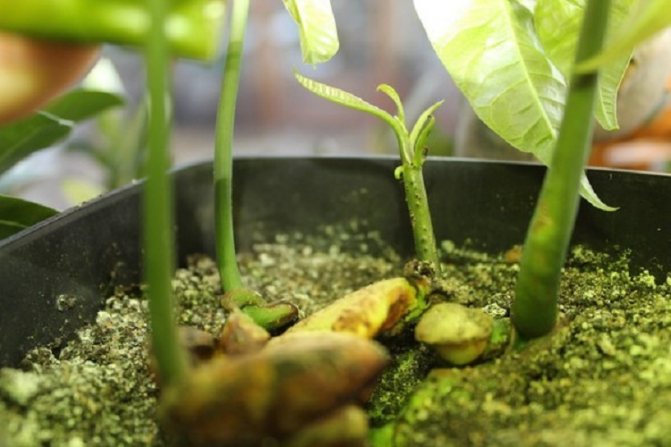

A week after germination, the sprout is carefully removed from the temporary dwelling along with the entire earthen lump and placed in the main pot. It is installed in a well-lit place.
- Frequent watering with moderate amount of water. Overflow will cause decay.
- Irrigation every other day. Light warm shower every week.
- A fast growing tree will be grateful to you for nitrogen complexes. They feed him every week. In the autumn period, once every 30 days. During hibernation, it is better not to disturb him with top dressing.
- The tree grows well at 25-30 C. Therefore, in the autumn winter period, take care of the appropriate temperature.
- The root system does not tolerate interference. Frequent transplants injure her.
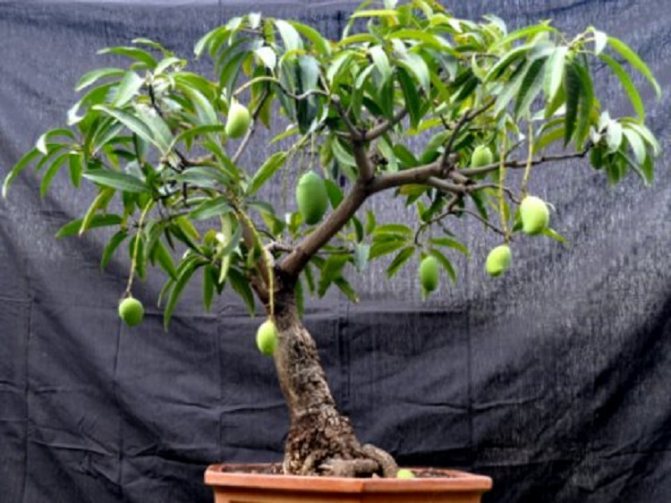

The branches are cut after the tree reaches a meter height. Such a manipulation is carried out twice a year. Be sure to remove weak, dry twigs. It is best not to prune with bare hands. Mango tree juices are poisonous and can provoke an allergic rash.
Appearance
Outwardly, the mango tree looks very majestic: it can grow up to 30 meters long, and with a wide rounded crown over the years it grows up to 40 meters wide, straightening and thinning towards the top. The root on well-fertilized soil is able to go 6 meters deep with the germination of supporting stem branches.
The mango tree is practically an evergreen long-liver: it can grow and bear fruit for 300 years. It looks very beautiful during flowering, densely covered with small flowers of yellow or red shades. The shape of the fruit can vary in shape, color and quality. Round, oval, oblong - they are almost always somewhat curved. The size of the fruits can vary between 7-25 cm. By the color of mangoes, there are green, yellow, pink, red and even grayish and lilac shades when ripe. The pulp can be either pale yellow or bright orange. Inside the fruit there is a yellowish-white flat oval stone, from which, by the way, a tree can be grown.
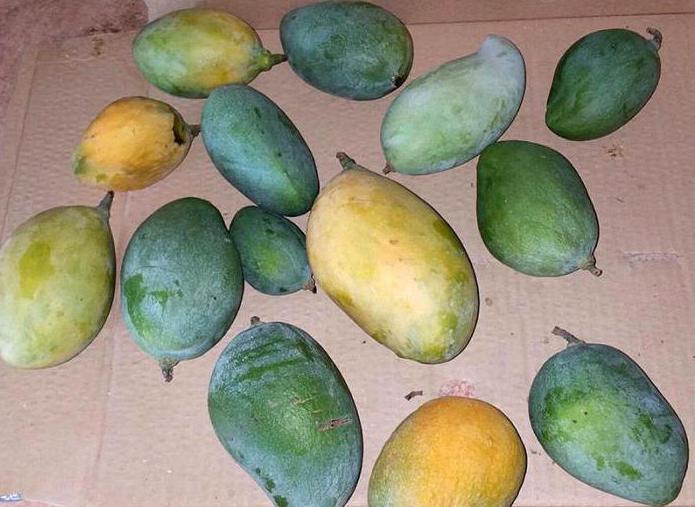

Does mango grown from seed bear fruit?
Only a grown tree from a cutting can be fruitful. A beautiful tree will sprout from the seed, but decorative, without flowering and fruiting. In order for it to bear fruit, you need to graft. For grafting, use a branch or buds of a fruiting mango tree.
The first flowering after the scion will appear in 2 years. If you did everything correctly, then after flowering a quarter later, you will receive the first fruits. A grafted tree needs special care, the soil is fertilized with special means. This is especially true during flowering and ripening.
A tree that sprouted from a purchased fruit is much weaker than that grown from a cuttings. The fruits that reach our counters are harvested from tall mango trees. Low-growing trees are better suited for the home. It is best to buy them in greenhouses.


Summing up:
Mango trees can be grown by themselves using the seed material of overripe fruits. Ideally, of course, to acquire fruits, plants from which do not need to be grafted. Vaccination is needed so that the tree is not just decorative, it pleases with its fruits. Today there are many nurseries with exotic trees. Having visited such a greenhouse, you can buy a stalk that gets along well in the apartment. For open areas, you need to take a more serious approach to the choice, because not all varieties take root in cold climates.
Optimal conditions
Exotic fruits grow and bear fruit wonderfully in tropical, warm and humid climates. The ideal place where dates, mangoes, pomegranates and papaya grow are India, South and East Asia, East Africa, Malaysia and other countries with similar temperature regimes.
Mango trees need a frost-free climate. Even a short cold snap to +5 degrees Celsius will lead to the death of the fruits and flowers of the "Asian apple". Young trees are not able to withstand even short-term frosts; adult specimens can withstand short temperature drops.
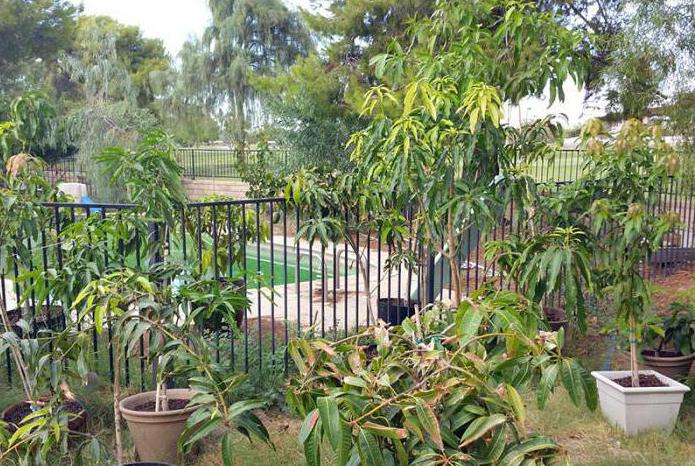

Interesting Facts
- Since ancient times, the Hindus, who consider the mango tree sacred, attributed to it the ability to fulfill desires. So, in India, where mango grows, they believe that by hanging this fruit on the door of the house on New Year's Eve, you can attract happiness and grace to it. And the Hindus also use mango twigs to brush their teeth during the holy holidays.
- For all the benefits and extraordinary taste of the “great fruit,” burning mango leaves produces toxic gases that cause serious eye and respiratory irritation. The leaves of this tree are poisonous to cattle. Curious: in India in ancient times, a shade of yellow dye was obtained by feeding cows with mango leaves (in small quantities) and then collecting urine. Of course, this way of feeding sacred animals with toxic leaves was illegal.
- The annual volume of mango cultivation is about 20 million tons. And although the main country where mango grows is India, on European counters this fruit is predominantly of Spanish "production".
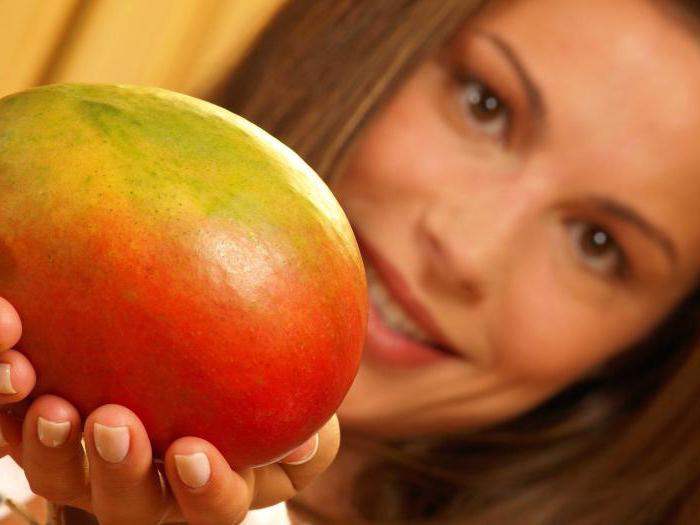

The two main varieties of mango are Indian (rounded, red or yellow) and Indo-Chinese (elongated green fruit). All others are hybrids of these two representatives.
(Mangifera indica)
I continue to research the fruits that make up Xan Vitan mangosteen juice — tropical mango fruit.
History: India is considered the birthplace of mango, where for more than 4 thousand years this tropical fruit has been a favorite delicacy of both nobility and commoners.
No wonder one of the most famous rulers of the dynasty of the great Mughals, Jalal ad-din Akbar, became famous not only as a wise politician who expanded the borders of the empire, but also as a far-sighted business executive who ordered to lay out a garden of one hundred thousand mango trees on the Ganges plain.
Preparing for landing
If you are going to plant a mango at home, you will need, first of all, the mango itself. Soft, ripe, even overripe, but not stale and without damage - such a fruit is ideally ready to sprout.
Important! For growing mangoes, be sure to choose a windowsill on the sunny side. Mango does not tolerate cold, abundant light and warmth are vital to it.
You will also need:
- a small pot with drainage holes;
- special soil;
- knife;
- water;
- plastic bottle.
For the initial planting, pick up a small pot, slightly larger than a glass. Buy soil in specialized stores or flower departments, it is preferable to contain peat and sand in its composition. Light soil for succulents with an admixture of expanded clay or pebbles is a suitable option.
Watering
Question:
How to properly water a young plant?
Answer:
Mango trees are very fond of moisture. However, you cannot overdo it with watering. If the plants receive too much liquid, then root decay will begin. Care must be taken to ensure that the soil always remains moist. It is especially important to observe this condition when growing young sprouts and trees up to 5 years old.


As soon as the plant begins to feel dry, its leaves instantly wither and fall off. This is a sure sign that you need to increase your watering frequency and regularity.
If, after flowering, the fruits begin to knit, then the number of waterings is immediately reduced to a minimum. The mango should be returned to the optimal watering regime only after harvest. On average, you need to water once every 3-5 days. But it depends on the temperature in the room or outside.


For example, during the summer months, when the heat is intense, mangoes may need to be watered daily. For irrigation, use settled water at room temperature. It is also used for spraying once every 2-3 days.
Dangerous pests and diseases
Spider mites are a big danger to tropical trees.Their sign is the emerging cobweb. High temperatures and lack of moisture can be the cause. In warm weather - thrips, which feed on the sap of the leaves. This can be seen by discoloration or discoloration of the leaves.
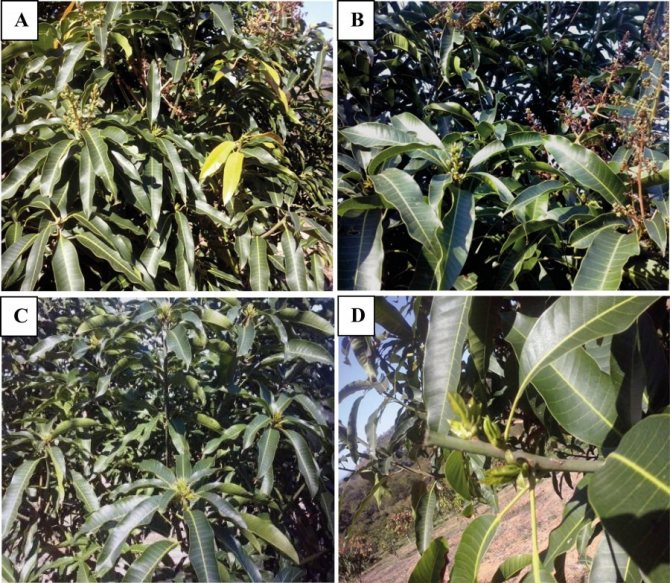

- Olives - what is their feature? Useful properties for humans, 120 photos of fruits
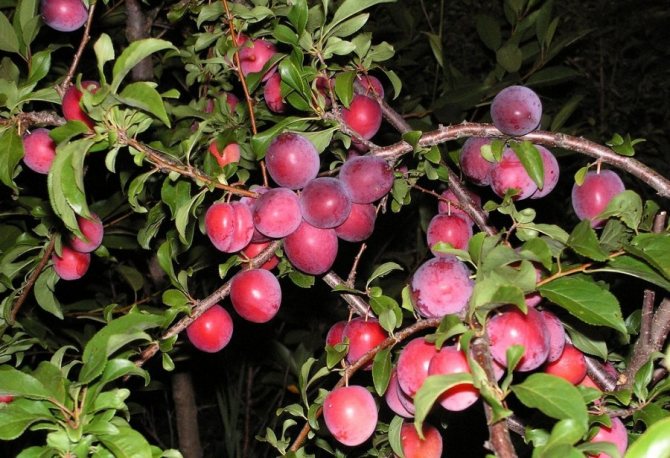

Cherry plums are the best varieties of fruits. 115 photographs and a detailed overview of all the properties of cherry plum for humans.
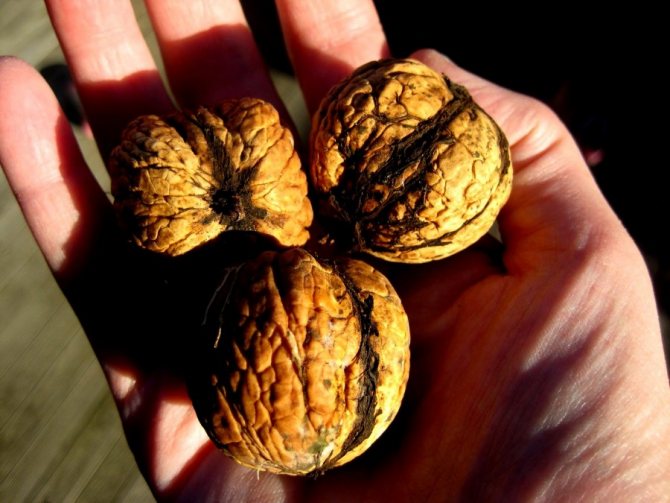

Walnut tree - useful properties. How to plant and care for a tree (110 photos)
Common mango diseases:
- powdery mildew - white bloom on the leaves;
- bacteriosis - spots on the leaves;
- anthracnose.
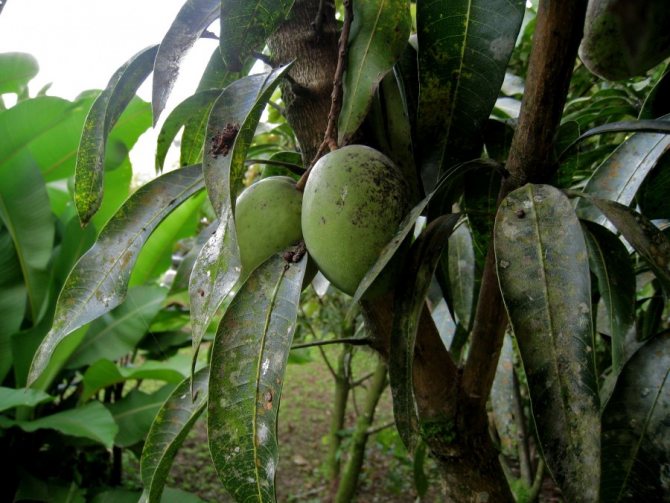

Dry air will color the tips of the leaves brown. And in the cold, the flowers will simply fall off.
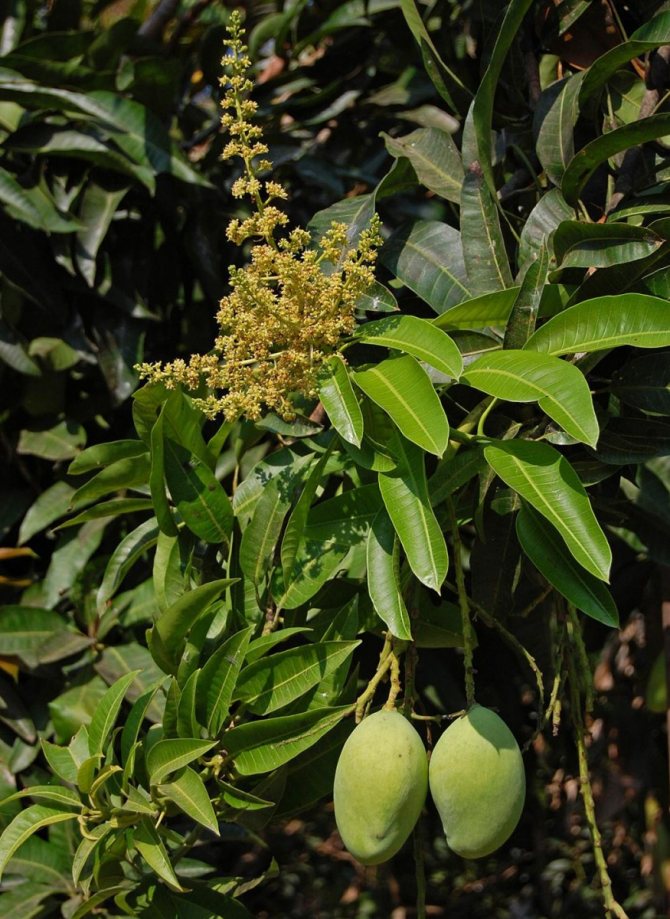

Planting process
- We extract the stone from the ripe fruit. To do this, cut it in half, take out the bone and clean it from the remnants of the pulp.
- If the fruit is well ripe, the seed may have already opened. Otherwise, you will need to open it yourself with a knife. This is done so that the sprout can easily and easily penetrate the ground and quickly begin to develop. Remove the seed from the shell carefully so as not to damage it. If the bone is very dense and it is impossible to split it, leave it to ripen. To do this, wrap the bone with a wet napkin and put it in a warm place. Remember to add water periodically to keep the napkin moist at all times. It can take up to two weeks for a seed to germinate.
Important! You need to clean the bone and extract the seed only immediately before planting in the ground. In order to prevent the formation of mold and pests, you can pre-treat the seed with a fungicide.
- Pour a 2 cm layer of pebble drainage onto the bottom of the pot. Fill the pot with soil. Dig a hole in the center up to 3 cm deep, pour warm water and place the seed in the ground with the sharp end down so that a quarter of it remains above the ground. You do not need to fill up this part. If you position the seed correctly, then its root will be below, and ¼ part of it will be on the surface. Now water the planting thoroughly.
- We build a mini-greenhouse over the pot. To do this, cut off the plastic bottle and put the top with a lid on the pot. Now place the pot in a warm, well-lit place and wait for the shoots to emerge. Open the bottle cap periodically to allow air to flow. The bottle can be replaced with cling film stretched over the surface of the pot.
- The first shoots appear after about 3-4 weeks. All this time, do not forget to maintain moderate humidity and ensure a consistently high temperature (not lower than 22–25 C °).
- Young shoots need light, warmth and moisture. In addition to regular watering, spray the seedling.
- The grown, matured seedling is planted in a more spacious pot filled with fertile soil.
Step-by-step process in the photo
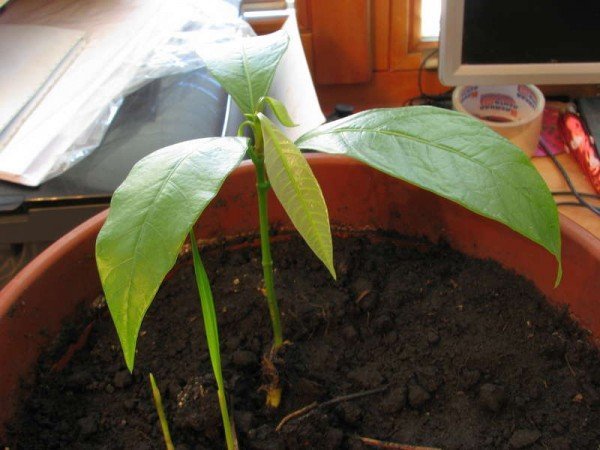

The strengthened seedling is transplanted into a more spacious pot


The first shoots will appear in a few weeks
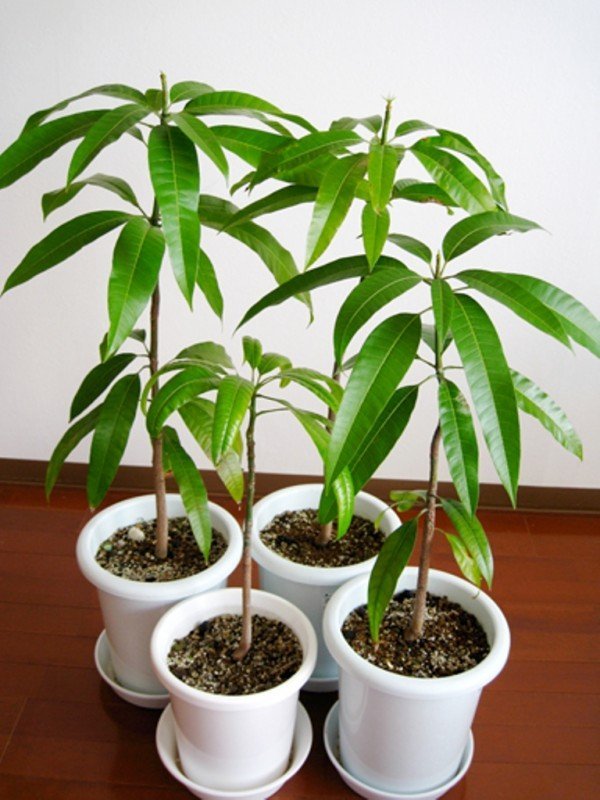

Place the mango in a well-lit area


Free the seed from the shell
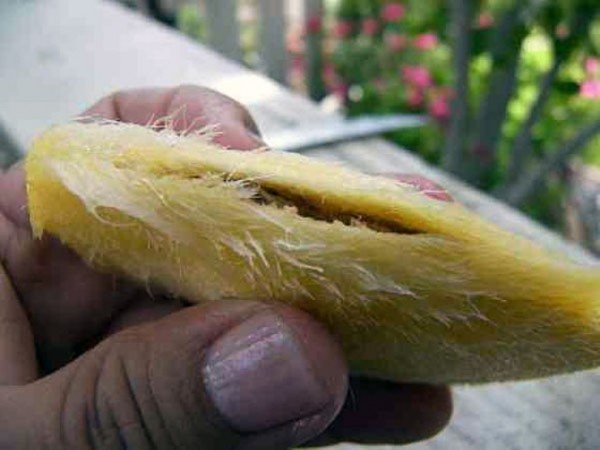

Peel the bone from the pulp
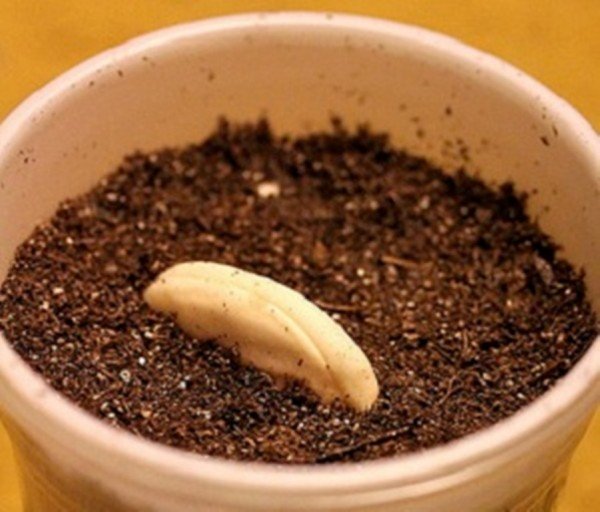

Place the seed in the soil with the sprout down, leaving 1/4 part of it on the surface


